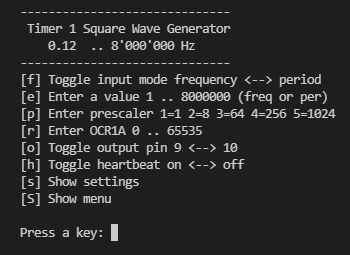4. User Interface
The user interface is a simple command line interface. The menu items are self-explanatory.

If not exact frequencies are required for a test, this generator can be quite useful. Since prescaler and register can also be manipulated directly via the CLI menu on the serial monitor and the calculated values are displayed, this deepens the understanding of the interaction of prescaler and register.
No wiring necessary
The user interface is a simple command line interface. The menu items are self-explanatory.

And this is how it looks in the program code:
TCCR1A = 0; // clear the register if (pin == 9) TCCR1A = 1 << COM1A0; // set output pin if (pin == 10) TCCR1A = 1 << COM1B0; TCCR1B = 0b00001001; // Prescaler = 001 = 1 // ^--- // | | // | prescaler bits, // WGM12 bit for CTC mode TIMSK1 = 0; // clear the registerBut the most important thing is still missing. How must the bits of the prescaler and the value of the output compare register be set? For this we still need some definitions and formulas:
prescaler: 3 least significant bits of TCCR1B = 0b00000xxx
stand for a divider of 1, 8, 64, 256, 1024 for fo
compare value: OCR1A (output compare register) contains values 0x0000 .. 0xFFFF
fo 8'000'000 (half of fcpu)
f desired frequency in Hz
T desired period in seconds
Tus desired period in microseconds
ocr content of 16-bit register OCR1A
f = fo / ((ocr + 1) * pre), fo = 8'000'000 Hz and pre = 1, 8, 64, 256, 1024
T = (ocr+1) * pre / fo
ocr = fo / f / pre - 1
ocr = T * fo / pre - 1
= Tus * 8 / pre - 1
If the value of ocr is greater than 0xFFFF, the next higher prescaler is taken
The tables below show the resulting frequencies and periods for the possible
prescalers and the ocr values 0x0000 and 0xFFFF.
Resulting frequencies [Hz]
--------------------------------------------------------------
pre = 1 8 64 256 1024
--------------------------------------------------------------
ocr = 0x0000 8000000 1000000 125000 31250 7812.5
ocr = 0xFFFF 122.0703125 15.25878906 1.907348633 0.476837158 0.11920929
Resulting periods [us]
--------------------------------------------------------------
pre = 1 8 64 256 1024
--------------------------------------------------------------
ocr = 0x0000 0.125 1 8 32 128
ocr = 0xFFFF 8192 65536 524288 2097152 8388608
With this knowledge we can now calculate the value for the 16-bit register OCR1A. To get the best accuracy, we convert the 32-bit integers of fo, freq and pre to floating point numbers, round the result and convert back to a 16-bit integer for the ocr value.
OCR1A = (uint16_t)(round( (double)fo / (double)pre / (double)freq - 1.0 ));
Interested? Please download the entire program code. The zip-file contains the complete PlatformIO project.
My programming environment is not the native Arduino™ IDE but PlatformIO™ on top of Microsoft's Visual Studio Code™. This combination offers many advantages and allows a much better structuring of the code into several modules especially when we adopt The Object Oriented way.